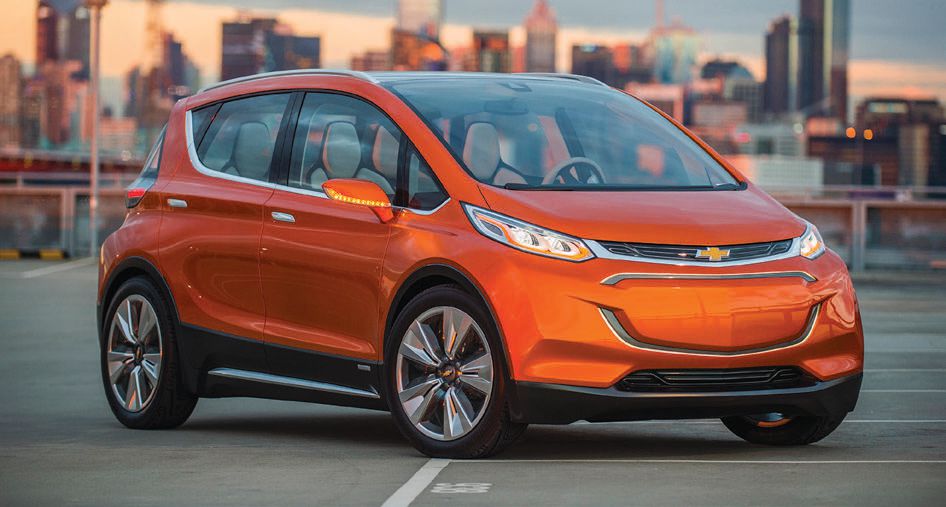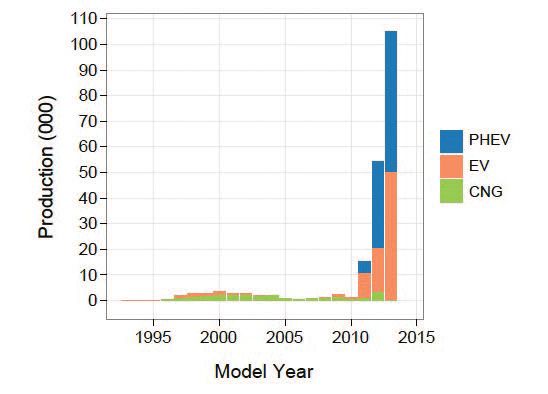The upcoming Bolt
Dr. Edward P. Becker | TLT Automotive Tribology April 2016
Electric and hybrid vehicles are on the rise.

THE GROWTH IN ELECTRIC VEHICLES AND PLUG-IN HYBRIDS in the U.S. (see Figure 1) is quite impressive over the last few years. Although the 105,000 total units represents only 1.3% of all new vehicles in 2014, the growth rate suggests a bright future for these vehicles.

Figure 1. Historical production of compressed natural gas (CNG) vehicles, electric vehicles (EV) and plug-in hybrid electric vehicles (PHEV) (1).
The EPA classifies the Chevrolet Volt as a plug-in hybrid electric vehicle (as opposed to GMs’ classification of “extended range electric vehicle”). The Volt sold just over 18,000 units in 2014, making it the top-selling plug-in hybrid. Although GM did briefly enter the electric vehicle market with the famous (or perhaps infamous) EV-1 in 1996-1999, the best-selling electric car in 2014 was the Nissan Leaf. However, that may be about to change.
The Chevrolet Bolt (not to be confused with the Volt) was first unveiled as a concept car at the North American International Auto Show in Detroit just over a year ago. Scheduled to debut as a 2017 model (2), the Bolt may be available by late 2016 in the U.S. Taking such a vehicle from concept to production in under two years would be quite an accomplishment for GM.
The Bolt is an all-electric vehicle, and GM claims to achieve a 200-mile (320 km) range on a single charge. Although the Tesla Model S claims a higher range (about 30% more), the Tesla also costs twice as much as the projected price of the Bolt. The Bolt also claims a 0-to-60 mph (0-to-96 kph) time of under seven seconds (compared to approximately nine seconds for the Chevy Volt). This combination of range and performance is well within the envelope of acceptance for most consumers.
To achieve these numbers, the Bolt includes a number of innovations. Of interest to the practicing tribologist, the drive unit includes a gear and shaft mechanism—basically a transmission—to vary the speed ratio between the motor and the wheels. While most electric vehicles drive the wheels directly from the motor, the use of a transmission allows the motor to operate near its peak efficiency more often, thus increasing the range.
Another major step forward is the Bolt’s regenerative braking system. Although such systems are common in all electric and hybrid vehicles, the Bolt has an industry-first system that is capable of bringing the vehicle to a complete stop using only the regenerative brakes. Of course, the car has friction brakes, since there are limitations to the regenerative system, but under most normal conditions the driver will be able to accelerate, cruise and stop using only the accelerator pedal. The energy that is usually dissipated as heat in friction brakes will actually be converted to electricity (basically the electric motor acts as a generator when absorbing the excess energy) and, in turn, recharge the batteries.
REFERENCES
1. United States Environmental Protection Agency Report EPA-420-R-14-023a, (October 2014), Light-Duty Automotive Technology, Carbon Dioxide Emissions, and Fuel Economy Trends: 1975 Through 2014.
2. www.chevrolet.com/bolt-ev-electric-vehicle.html.

Ed Becker is an STLE Fellow and past president. He is president of Friction & Wear Solutions, LLC, in Brighton, Mich., and can be reached through his website at www.frictionandwearsolutions.com.